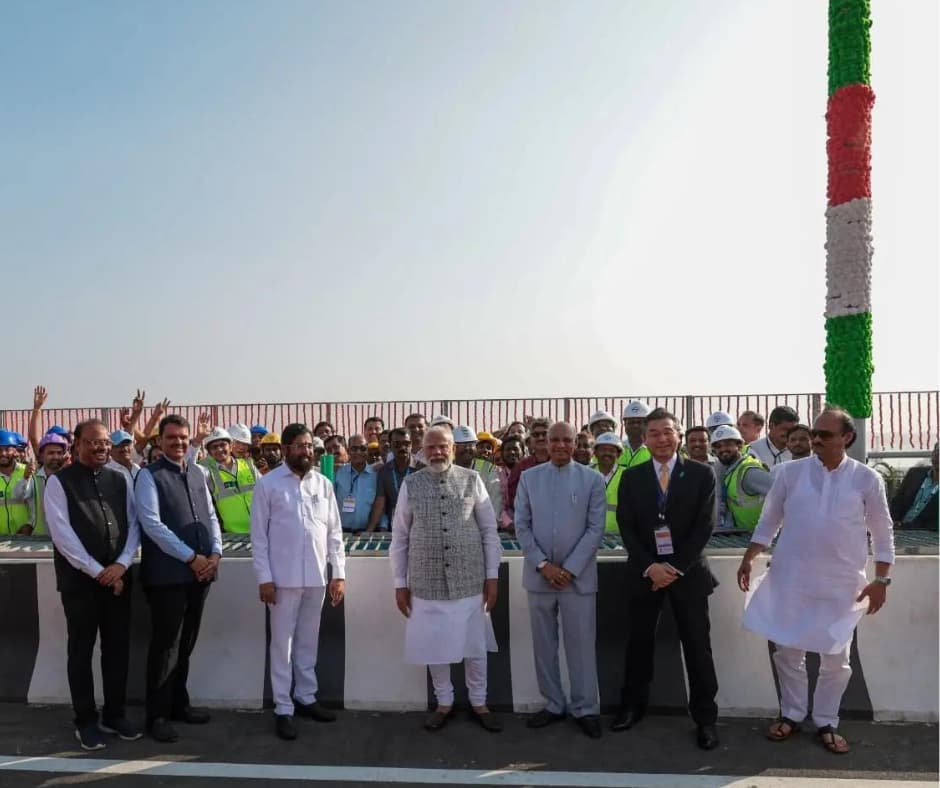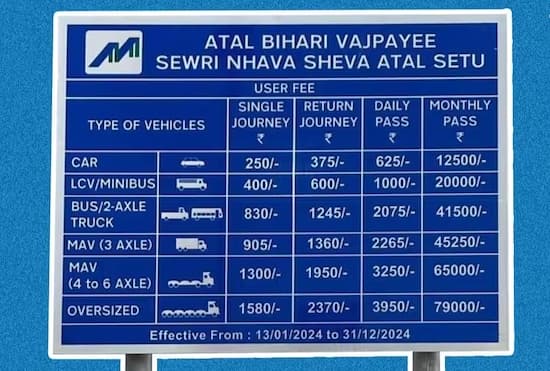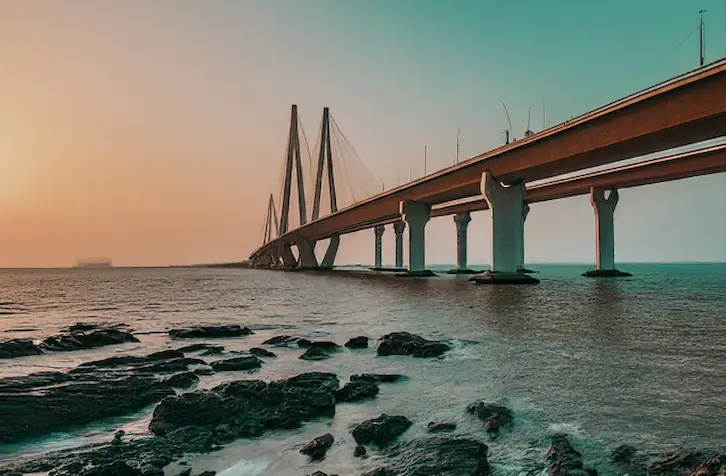The Atal Setu, India’s longest sea bridge, is a significant milestone in India’s infrastructure development. The bridge connects Mumbai and Navi Mumbai, reducing the distance between the two cities to just 20 minutes, which earlier took 2 hours. The bridge has been constructed at a cost of ₹18,000 crore and is expected to boost economic development in Navi Mumbai and other nearby areas. The bridge is named after former prime minister and late BJP veteran Atal Bihari Vajpayee. The bridge is a technological marvel and an environmental triumph, incorporating several technologies that were used for the first time in India.
Table of Contents
The bridge is anticipated to stimulate real estate activity in Navi Mumbai, particularly in micro markets like Panvel, Ulwe, and Dronagiri. The Atal Setu incorporates an Open Road Tolling (ORT) system, allowing vehicles to pass through toll booths without stopping, reducing traffic congestion and improving air quality. The bridge stands as a testament to India’s commitment to modernise its infrastructure, offering a faster, more efficient, and environmentally conscious transportation solution for the people of Mumbai.
The Atal Setu is expected to have a significant impact on the real estate sector in Navi Mumbai. The bridge is anticipated to stimulate real estate activity in Navi Mumbai, particularly in micro markets like Panvel, Ulwe, and Dronagiri. Connectivity improvements are expected to lead to a surge in property prices, making these areas more attractive to professionals seeking affordable luxury close to prime locations. The bridge is also expected to boost economic development in Navi Mumbai and other nearby areas.
The Atal Setu incorporates several new technologies that were used for the first time in India. The bridge incorporates an Open Road Tolling (ORT) system, allowing vehicles to pass through toll booths without stopping, reducing traffic congestion and improving air quality. The bridge also incorporates a state-of-the-art seismic design, which makes it resistant to earthquakes. The bridge is also designed to withstand high wind speeds and tidal waves.
The Atal Setu is a significant milestone in India’s infrastructure development. The bridge stands as a testament to India’s commitment to modernize its infrastructure, offering a faster, more efficient, and environmentally conscious transportation solution for the people of Mumbai. The bridge is expected to have a significant impact on the real estate sector in Navi Mumbai, boosting economic development in the region. The Atal Setu is a technological marvel and an environmental triumph, incorporating several new technologies that were used for the first time in India. The bridge is named after former prime minister and late BJP veteran Atal Bihari Vajpayee, who was a strong advocate of infrastructure development in India.
What are the Features of Atal Setu That Make It Unique
The Atal Setu is a unique and remarkable infrastructure project of India due to several features that make it stand out. Some of these unique features include:
Earthquake-Resistant Design: The bridge incorporates earthquake-resistant technology, enabling it to endure various types of earthquakes, with magnitudes up to 6.5 on the Richter scale.
Orthotropic Steel Deck: This feature, a first in India, provides the bridge with extensive spans, enhancing its structural integrity.
Reverse Circulation Rigs: Implemented to reduce sound and vibrations, these rigs help minimize noise and vibration caused by vehicles passing over the bridge.
Open Road Tolling (ORT) System: The Atal Setu incorporates an ORT system, allowing vehicles to pass through toll booths without stopping, reducing traffic congestion and improving air quality.
State-of-the-Art Seismic Design: The bridge is designed to withstand high wind speeds and tidal waves, ensuring its stability in various weather conditions.
Environmentally Friendly: The bridge is expected to save substantial amounts of fuel and reduce CO2 emissions, contributing to a greener and more sustainable future.
Real-time Traffic Information: The bridge will have displays placed at certain intervals to provide real-time critical information about traffic jams or accidents on the route, helping commuters make informed decisions.

These features make the Atal Setu a state-of-the-art infrastructure project in India, offering a faster, more efficient, and environmentally conscious transportation solution for the people of Mumbai
How Will Atal Setu Impact the Transportation System in Mumbai
The Atal Setu is set to have a transformative impact on the transportation system in Mumbai. Here are some of the key ways it will influence the city’s infrastructure:
Reduced Commute Time: The bridge will significantly reduce travel time between Mumbai and Pune, as well as provide connections to upcoming areas such as the Navi Mumbai Airport.
Boost to Real Estate: The bridge is expected to stimulate real estate activity in Navi Mumbai, particularly in areas like Panvel, Ulwe, and Dronagiri. This is anticipated to lead to a surge in property prices, making these areas more attractive to professionals seeking affordable luxury close to prime locations.
Environmental Impact: The Atal Setu incorporates an Open Road Tolling (ORT) system, allowing vehicles to pass through toll booths without stopping, reducing traffic congestion and improving air quality. It is also expected to save substantial amounts of fuel and reduce CO2 emissions, contributing to a greener and more sustainable future.
Enhanced Connectivity: The bridge will improve connectivity between key economic zones such as the Mumbai-Pune Expressway, the JNPT Port, and the Mumbai-Goa highway, opening up new opportunities for economic development.
The Atal Setu is poised to revolutionize commuting in Mumbai by reducing travel time, boosting real estate prospects, and driving economic growth through enhanced connectivity and environmental benefits.
What is the Atal Setu Toll Tax Rate?
The Atal Setu Mumbai toll price is as follows:
- For a single journey, a passenger car will be charged ₹250.
- For a return journey, the toll for a passenger car will be different.
- The rates for daily and frequent travellers will also be different
- The toll charges for other vehicles vary, with different rates for mini buses, buses/2-axle trucks, 3-axle trucks, 4-6 axle vehicles, and oversized vehicles.
- The toll rates are set to be revised after one year from the commencement of operations

Which places does the Atal Setu Bridge connect?
The Atal Setu bridge is 21.8 km long and has six lanes, reducing the distance between Mumbai and Navi Mumbai, as well as providing a connection to the Navi Mumbai International Airport and other areas in south India. The Atal Setu bridge connects the following places:
- Origin: The bridge starts from Sewri in Mumbai.
- Destination: The bridge ends at Nhava Sheva in Uran taluka, situated in the Raigad district.
- Intermediate Stops: The bridge also provides a connection to areas such as the upcoming Navi Mumbai International Airport and other parts of south India.
Is Atal Setu open for public?
Yes, the Atal Setu, also known as the Mumbai Trans Harbour Link, has been inaugurated and is now open for public use. The bridge was inaugurated by Prime Minister Narendra Modi on January 12, 2024, and was thrown open for motorists from the following day, allowing for reduced travel time and improved connectivity between Mumbai, Navi Mumbai, and other areas. The bridge is expected to have a transformative impact on the transportation system in the region, reducing travel times and driving economic development. The toll charges for the bridge have also been announced, and the rates will be revised after one year from the commencement of operations.
What is the route of atal setu—start and end point?
The Atal Setu bridge, also known as the Mumbai Trans Harbour Link, spans a length of 21.8 kilometers with six lanes. It originates from Sewri in Mumbai and concludes at Nhava Sheva in Uran taluka, situated in the Raigad district. The bridge is the longest sea bridge in India and is expected to have a significant impact on the region, reducing the distance between Mumbai and the satellite city of Navi Mumbai, as well as the Navi Mumbai International Airport and the state’s second largest city, and further to Goa and the rest of south India.
The bridge is open for public use, and the toll charges for a single journey for a passenger car is ₹250, with different rates for other vehicles. The bridge is expected to stimulate real estate activity in Navi Mumbai and its surrounding areas, leading to a surge in property prices. The bridge is also anticipated to ease the burden on the existing Vashi-Mankhurd bridge and Thane–Airoli bridges, and the Mumbai Police has set a maximum speed limit of 100 kmph for four-wheelers on the bridge.
Atal Setu is From Where to Where
The Atal Setu, also known as the Mumbai Trans Harbour Link, is a 21.8 km long sea bridge that connects Mumbai to Navi Mumbai and the upcoming Navi Mumbai International Airport. The bridge starts from Sewri in Mumbai and ends at Nhava Sheva in Uran taluka in the Raigad district.
The Atal Setu is expected to reduce travel time between Mumbai and Navi Mumbai, as well as provide a connection to areas such as the Navi Mumbai International Airport and other parts of south India.

Bhawna Anand is a talented content writer and editor with over 5 years of experience crafting engaging content for Abmantra, a popular blogging website. Her areas of expertise include Fashion, Festival, Gifting, Ecommerce, Spiritual and Travel content. Bhawna’s informative and engaging writing style has helped Abmantra attract a loyal readership and build a strong online community.
When not at work, Bhawna enjoys traveling the world, which often inspires her to write captivating travel pieces that transport readers to new destinations. She also loves to sing, cook, and read good novels.

